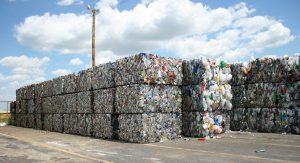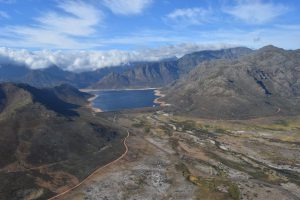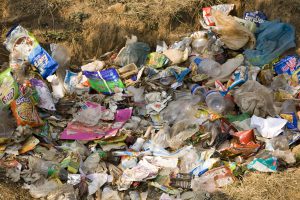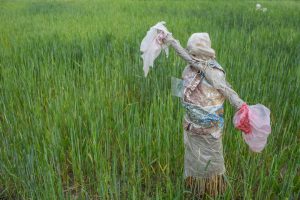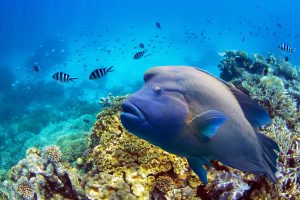Marcy Trent Long: This is Eight Million – a podcast series that looks at the eight million metric tonnes of plastic entering our oceans every year – and what role China plays in addressing this global challenge. Eight Million is produced by Sustainable Asia and its partners China Dialogue and Aya Recording Studio.
Marcy: Previously on Eight Million…
Craig: We walked along the beach every morning and there were dozens of these dead birds.
Jenna: Eight million metric tonnes of plastic going into our ocean in that one year.
Bill: What do you need to do with plastic? You need to stop the source, contain the release.
Marcy: At the heart of any great civilisation, you’ll find a river. China is no different. According to legend, China’s first dynasty was founded by Yu the Great, after he learned to control the waters of the Yellow River. Ever since, China has relied on its three major rivers for trade, transport, and energy; in fact, most of the country’s megacities still lie along the Yangtze, Yellow, or Pearl River.
Rivers are key to the development of this enormous country, but they also carry the unfortunate backwash of rising prosperity: increasing amounts of industrial, commercial, and municipal waste.
In this episode, we’ll look at the state of plastic pollution in China’s rivers, and review the country’s unique approach to resolving the issue.
Marcy: So, if you remember from last episode. American researcher Jenna Jambeck estimated that every year, about eight million metric tonnes of waste enters our ocean. She reached this number by looking at how much plastic waste is generated on average by citizens of each country, and then looking at how many people live by the coast and are likely to see this waste end up in the ocean. I decided to ring up lead scientist Laurent Lebreton – a French native living the dream in New Zealand.
Laurent: We went a bit further. We basically categorised all land into different watersheds and for every watershed we estimated how much run off there is…
Marcy: So Laurent and his team went and looked at the river systems, and calculated the amount of people living along these rivers and how their waste is managed.
Laurent: That’s how we figured out the five rivers that are most likely to carry waste into the ocean, and three of those are in China. The number two and five are in India and Cameroon. We’ve also noticed worrisome results in countries like Indonesia and the Philippines, so it is definitely worth looking into waste management solutions that can work for developing nations around Asia.
Marcy: Aside from making estimates around watersheds, Laurent and his fellow scientists also compared results from ocean plastic monitoring campaigns, such as measurements made by Hong Kong based researcher Lincoln Fok.
Lincoln: Back in 1998-1999, me and my now-retired supervisor were studying water…
Marcy: Lincoln studied microplastics on Hong Kong beaches. He and his team combed 25 local beaches, finding an average of 5,500 pieces of microplastic per square metre. That’s twice the amount found on US beaches, and still 50% more than found on the coast of South Korea. They also noticed that beaches facing west contained a lot more of this type of pollution, and west is where the mouth of the Pearl River lies.
Lincoln: If we found more deposition on the west coast, that naturally means there is a significant source of this pollutant in that area.
We believe that this large river is one potential and significant source of microplastics into the estuary.
Because there is currently no effective solution to remove microplastics from the environment, except for beach and coastal cleaning, I would think that the government or other organisations cannot do much about it. This points to the importance of preventative methods to reduce or stop plastics from entering the environment.
Marcy: And that’s what we concluded in episode one of this series as well: It’s nearly impossible to fish these plastic bits out of the water, so we really need to stop the problem at the source.
Now, what is China doing to stop pollution from flowing into river systems? I asked this question to Hu Feng, at China Water Risk, a non-profit here in Hong Kong that researches China water quality.
Hu Feng: Most people know that China has serious water issues, and addressing these issues has always been in the top priority of government policy in recent decades.
Marcy: Feng explained that the Chinese government wants to stop the damage being done to the environment
Hu Feng: In 2014, the premier Li Keqiang declared war on pollution including air pollution and water pollution, basically start more stringent actions from all departments within the government to tackle these issues. […]
So we have a saying that Nine Dragons manage water, because – probably similar to other countries, the water is not only about water usage it is also about pollution and managing water in agriculture and all kinds of economic activities. So all these responsibility under different departments. To address these you need different departments to work together to form a more holistic management policy to address our current water challenge in China.
Marcy: Feng also told me about the Water 10 Plan, a 2015 blueprint for bringing these different departments together. And all of this is happening under the wonderful label of…
Hu Feng: A Beautiful China.
Marcy: Beautiful China. měilì zhōngguó. It’s one the taglines of China’s leader Xi Jinping. I discussed this with Christine Loh. Christine has spent the last twenty-five years influencing environmental policy in the Pearl River Delta through her work as a Hong Kong legislator, under-secretary for the environment, and CEO of the independent think tank Civic Exchange. She is heading to UCLA this spring to teach a course on policy and business, but with me she shared her knowledge on how vision becomes reality in China.
The notion of a ‘Beautiful China’ encompasses a vision about how Chinese people can live
Christine: I think the Chinese government have been travelling on a path of thinking about what they want China to be – a vision for China. And obviously the Chinese government and the Chinese communist party has been thinking about really what that means for them and how to implement it. And they have come up with this concept of ecological civilization not as a counterpoint to sustainable development, as sustainable development is a concept that they accept, but to really think through that going from where they are today, how can they save the environment and see civilisation – how they live – the Chinese civilisation – how they go forward.
So today the notion of a beautiful china encompasses a vision about how Chinese people can live. So they have already talked about poverty alleviation. So the last thirty years has really been about how to get people out of the most dire poverty, and the Chinese government has now gotten to a point where they can say ‘well we think we have gotten rid of the worst kind of poverty.’ It doesn’t mean that everybody is very materially wealthy, in fact they are not quite sure that is the path to follow. They have always said that they have a certain fear that China is going to end up like a typical western society which is highly materialistic. That is why they say our vision and our policy and our aim has been for people to reach a kind of middle class society.
OK now that that is going to be accomplished around 2020, China is saying we need to have a new development path of ecological civilisation that will result in a Beautiful China and a Beautiful China must mean a clean environment! That is really the narrative. Now they are rolling out more and more policies – now that doesn’t mean they are only starting now. In fact over the course of the last ten years they have been rolling gradually out more and more environmentally related policies.
Marcy: In China, decisions are made at the top, and then the rest of the country is expected to follow suit. At least, that’s the plan. I mean, how do you get 1.3 billion people to put words into action?
Christine: So the first thing you have in China is you have party schools, and schools for administrators. and these are mandated. If you are provincial governors and different levels of officials and so on, every so often you have to go to party school if you are a party member. If you are not a party member, you still need to go to some kind of administrators school. There you could go from anywhere between two weeks – I have heard people say they have gone for three months. So those are very intense sessions to understand what is national policy, what is party principles and policies. Of course, they are not just going there to learn one or two things, but it is an assemblage of how the party and the government thinks at any one time.
The second thing is that you have to show performance. And for quite a number of years, not just the pursuit of gross domestic product, you have to show that you have hit environmental targets. Social targets and environmental targets. So if you want to be promoted, you have to be able to show that you have hit those targets. That’s extremely effective.
Things are not done overnight. This is where I think it is different from a Western political system, where Western politicians can say I have an idea, this is the third way, or this is whatever… The Chinese are much more careful, they tend to say I need to study this issue, and then gradually it becomes more and more important if they think it works. So today at the 19th Party Congress, which is the latest, highest level, policy vision speaking you could say – it is about articulating a new path, a different focus, of development for the country. So that is why the 19th Party Congress is considered so important.
Marcy: The 19th Party Congress in 2017 is where Xi Jinping spelled out his ambition for a Beautiful China. And during the Party Congress, the Five Year Plan was approved, putting in motion new environmental targets that can be filtered down to local governments. I asked Zhang Chun, a journalist with China Dialogue, about the river and marine targets included in the Five Year Plan.
Zhang Chun: 一个是提出到2020年,近岸的这个海域水质达到优良的比例…
Voiceover: First, the plan will likely increase the quality of coastal waters; 70% of which should achieve Class I or II quality by year 2020, an improvement of 50% since 2004. Second, the coastline retention rate should be over 35%. That is to say that 35% of coastlines should be left in their original state – without reclamation and with no construction. These two targets are the only two binding goals, because meeting these targets are believed to affect the careers of local officials.
Zhang Chun: 唔,当然有不少。啊,新的规划当中…
Voiceover: This plan will lay the foundation for a series of controls over marine pollution, including: regulating the amount of pollutants to be released into important coastal areas, assessing the quality of coastal waters, and issuing licences to permit the release of pollutants.
Marcy: Class I and II quality designation for rivers means drinkable water. Feng continues:
Hu Feng: I think if the government can highlight the importance of water pollution prevention and control in the Five Year Plan, which means in following of action from different ministries they can allocate more efforts including… funding from different department towards research and development. So in the last year we already see the percentage of research and development in GDP reached 2.1% which is equivalent to many developed countries. And China wants to increase this percentage to 2.5% by 2020.
Marcy: So China is building up the capacity to deal with these issues, something which is a given in many developed countries. Just think of all the advisory boards to the US government.
Christine: If we rewind ourselves 15 years back, well China just didn’t have this.
So going forward you can imagine for China to able to implement and enforce policies, the army of officials and others that they have to put in place… So if you go to a university today you know studying environmental science, or the environment… It is a big deal. Because you can see in China, the funding and the policies are coming in – it’s all going to support these things happening. But of course, you can be highly critical in any one moment to say ‘Well have you done it?’, ‘No, I haven’t done it yet’, ‘Are you happy with the system?’, ‘No, we are not happy with the system yet, but there is going to be a lot happening.’
Marcy: So this is also how China is dealing with the plastic problem, ‘crossing the river by feeling the stones,’ as Deng Xiaoping famously said. Step by step, finding out which policies achieve the best results. Right now, government cadres around the country are being educated about the problem of river pollution, and possible solutions are being trialled in cities large and small. A good example of this local implementation is the so-called River Chief System. Yuanchao Xu, also of China Water Risk, explained it to me:
Xu Yuanchao: For each part of a river, there is a person who is in charge of that river. If the river is not going well then the person will be blamed and that will impact the person’s administrative assessment, which probably will affect the person’s future promotion.
Marcy: So a local administrator is pinpointed as the go-to person to report illegal dumping.
Xu Yuanchao: It is stipulated in the national River Chief document that every part of the river, there should be a notice board. On that board, you will see that the name of the River Chief, the context and the related information. Once you find a problem, you can just directly contact the River Chief or you can report to any other departments or bureaus and say ‘Blah, blah, blah is in charge of this river and now it has problems.’
Marcy: After trialling successfully in a couple of counties, the government decided to promote this scheme all over the country. And though it has some issues, it’s been quite effective as a step towards more government accountability for environmental pollution.
There is a lot of work to do, but like Christine said, there is a lot happening.
In our next episode, I’ll be talking to some experts on waste collection, to find out what the government is doing to achieve a Beautiful China.
Outro
This podcast was brought to you by Sustainable Asia.
Eight Million was produced by me, Marcy Trent Long, and the multi-talented Sam Colombie.
We could not have pulled this podcast series together without our amazing audio engineers Carsten and Annabat Martens of Aya Recording Studio.
Our logo and social media outreach was by Kinsey Long.
And special thanks to our voiceover artist Keon Lee, audio assistant Daniel Suen, and our wonderful partners at China Dialogue: Isabel Hilton, who helped formulate the idea for the project, Charlotte Middlehurst and Christopher Davy, for their editing skills, and Huang Lushan for stepping in with interviews and translation.
Share this podcast with your friends and colleagues! Education and collaboration are our best path for creating a Sustainable Asia.
Find it on APPLE PODCASTS | SOUNDCLOUD | SPOTIFY


